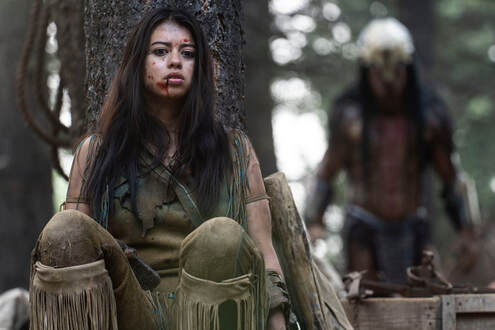B | An alien hunter lands in 18th century Dakota amongst Comanches and French trappers. Directed by Dan Trachtenberg Starring Amber Midthunder, Dakota Beavers, and Dane DiLegro Review by Jon Kissel |

The setting also allows for a casting coup with newly minted action star Amber Midthunder as Naru, a young Comanche woman who’d prefer hunting to tanning or medicine. Onscreen for almost all of the film, Naru provides a credible obstacle for the Predator, a creature who underestimates and discounts her abilities just as much as the young male warriors in her tribe. Trachtenberg captures the action to give maximal credit to Midthunder’s talent for physical choreography, filming in full frame or in single takes to show how much of the action she’s taking part in. At the same time, she uses skill and cunning to escape the Predator and fight back, taking advantage of his wounds while also just getting lucky at key points. The film doesn’t insist that she’s a better fighter than the warriors, including her brother Taabe (Dakota Beavers), who the Predator kills, only that each fight took something out of the Predator or taught her something about how to fight it. Naru earns her final victory, meticulously set up by the script step by step.
Prey provides a major opportunity for Midthunder and for the Native cast in a case of diversity done exactly right. The film doesn’t congratulate itself for being so forward-thinking, nor does it engage in nonsensical and condescending noble savage tropes. The tribe’s medicine isn’t magical, but herbal, borne of long traditions of trial and error. Some Comanches are jerks, some resist said jerks, others go along with their jerkery. The same is true for the French, who are driven by corrupt incentive but who individually can make the choice to be as cruel as their directive. Prey falls in line with some of my favorite depictions of Native cultures, or any culture not my own. The customs have their own utility and value, but the people are wholly recognizable as humans who operate on the cruel-charitable scale, just like everyone everywhere else does.
As the antagonist, former basketball pro Dane DiLegro bulks up to play the Predator, a role traditionally played by a guy in a suit as much as possible. The latest technology allows for a more integrated effect than the 1987 original, but that seems to have been done primarily with the camouflage effect of the Predator’s armor. The face itself has the tactility of a real thing. Powers-wise, the Predator always brings fun gadgets, and there’s a less technological feel to this version, like they figure out plasma rifles in the 19th century. He’s still got his contracting nets and his spears and his claws, but his gun is now remote control darts. The Predator’s variety in how it deals violence has long been its main draw, and we get plenty of that here, though it’s the raw punching out of a bear with his bare hands that is the most memorable. As the recipient of violence, there are some memorable blows that the Predator takes, none more than the incredible mid-shot of Taabe jumping off his horse and driving his spear through its shoulder. Imagining the reaction to that shot in a theater only makes me more irritated over how that isn’t going to happen.
Prey works as a great action film, with a pace and a plot that keeps things moving forward and with exceptional fight scenes that are unequivocally the best in the franchise. If the original is marginally superior, it’s because of the raw, corny testosterone pumping through the main cast. Prey loses nothing by casting a woman in the lead and surrounding her with skilled but scrawny young men. It’s even got a little emotional twinge with the repeated line of ‘this is where you/I end,’ a phrase that’s noble and knowing and resonant in a film that didn’t have to have any of those things. That phrase only applies within Prey, as its various components are at the beginnings of long careers in films that will hopefully play in theaters. B+
 RSS Feed
RSS Feed